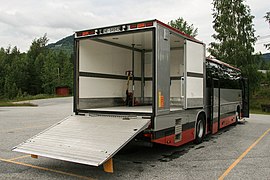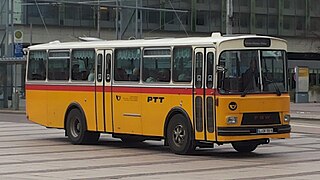Combination bus

A combination bus is a utility vehicle in which elements of a bus and a truck are connected to one another in such a way that passengers and goods can be transported at the same time or alternately. These vehicles are mainly used in sparsely populated areas with little traffic. The so-called articulated lorry buses are also a combination of a bus and truck , in which a universally applicable tractor unit is combined with a special trailer for passenger transport.
history
Germany
In 1907, the Kässbohrer Fahrzeugwerke from Ulm built the world's first combination bus. It could transport both people and goods by folding down the rows of seats that were attached lengthways. From 1910 Kässbohrer owned a patent for this mixture of bus and truck.
The combination bus had a wooden body based on a truck chassis from the Swiss commercial vehicle manufacturer Saurer from Arbon. For the first time, a closed, partitioned driver's cab was available to the driver . The vehicle had 18 seats and ten standing places. The first combination bus was used by an innkeeper to transport beer kegs, but also people if necessary. A year later, Kässbohrer built a combination bus with a partition, on which the padded individual seats in the front compartment could be folded up.
In rural regions, attempts are currently being made to revive the concept. A corresponding pilot project, albeit with conventional buses, was started in September 2012 in the Uckermark. Since June 30, 2016, all transport companies in Brandenburg have had the opportunity to receive funding of 70,000 euros for the introduction of the combined bus approach on existing lines in their service area.
Austria
In Austria, specially adapted trolleybuses operated on the Sankt Lambrecht trolleybus , which were also used to transport passengers. For this they had a spacious cabin with seven seats. Only employees of Dynamit Nobel AG were promoted.
Denmark, Norway and Sweden
In Denmark , Norway and Sweden , combined commercial vehicles made up of buses and trucks are known as combibuses. In Sweden, also by the same name is mythical animal derived name Skvader common.
After the Second World War, Skvaders were made by manufacturers such as Scania -Vabis, Volvo and Daimler-Benz . They were mainly used for mail and dairy transports. Skvaders were a widely used mode of transport in rural Sweden until the 1970s. The Skvaders were mostly built on the basis of an extended bus chassis and, in addition to milk cans and other goods, carried up to 17 (seated) passengers.
In the 1970s, the original Skvaders gradually disappeared after dairies began replacing them with tank trucks.
Later, vehicles with closed freight compartments were built the length of a coach. Viewed from the rear, they are trucks and, viewed from the front, coaches . The transition between the bus body and the box body that is common in trucks is not fluid, but is made up of special, but practical body parts over a length of just a few centimeters. The length of the cargo compartment is between a few meters and half the length of the vehicle, depending on the type. The vehicles are often equipped with a tail lift . In Norway, some of them are still used as public buses in sparsely populated rural areas.
Australia
The Western Australian Government Railways started using combined passenger and freight buses from 1949, which were referred to as passenger freighter.
United States
The Great Northern Railway had twelve combination buses built by the Kenworth company to replace railcars on a branch line in Montana . These were called Bruck, a suitcase word from bus and truck .
gallery
Kenworth Bruck on the Great Northern Railway , built in 1951
The FBW 50U is a line bus model that was also intended for the transport of mail.
Web links
Individual evidence
- ↑ Trucker: Fernfahrer-Magazin , No. 2/1994, ISSN 0946-3216, pp. 40, 41
- ↑ a b Olaf v. Fersen (Ed.): A Century of Automotive Technology: Commercial Vehicles , p. 301. VDI-Verlag, Düsseldorf 1987, ISBN 978-3-662-01119-5
- ↑ Otto-Peter A. Bühler: Omnibus technology: historical vehicles and current technology , Vieweg-Verlag, Braunschweig 2000, ISBN 3-528-03928-0 , online on google.books: [1] [2]
- ↑ Klaus Rabe: The beginning of all vice , Westermann-Verlag, Braunschweig 1985, ISBN 3-07-508991-5 , pp. 96, 97
- ^ Christian Muschwitz: Next stop: Quality of life. Key infrastructure kombiBus: mobility through multifunctional means of transport. ( Memento of the original from January 25, 2013 in the Internet Archive ) Info: The archive link was inserted automatically and has not yet been checked. Please check the original and archive link according to the instructions and then remove this notice. , in: Journal of the German Association of Cities and Municipalities Stadt und Gemeinde Interaktiv , Vol. 70, No. 1/2 2015, ISSN 1437-417X, pp. 10–13
- ↑ New KombiBUS guideline entered into force on interlink-verkehr.de, accessed on March 31, 2017
- ↑ Svenska Spårvägssällskapet: Sverige - PS no K90, Kungliga Poststyrelsen, "skvader"
- ↑ Jemtlands veteranbilklubb: Volvo B 727 1953 ( Memento of the original from September 29, 2008 in the Internet Archive ) Info: The archive link was inserted automatically and has not yet been checked. Please check the original and archive link according to the instructions and then remove this notice.
- ↑ Foden PVSC6 , Hino RC320P , Leyland Lion PSR1 / 1 on perthbus.info, accessed on March 31, 2017
- ↑ Lynnette Hintze: Historic Great Northern bus-truck restoration now ready for the road on dailyinterlake.com, October 27, 2005, accessed on March 31, 2017









